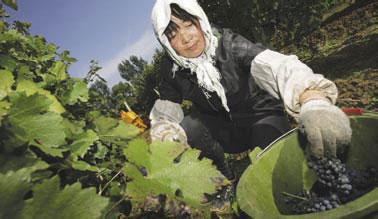Life and Leisure
Importers see hurdles to grow demand
By Lu Chang (China Daily)
Updated: 2010-10-29 11:26
 |
Large Medium Small |
|
A woman picks grapes at a vineyard in Changli, Hebei province. Cui Meng / China Daily |
BEIJING - Sales are soaring for wine importers as they cater to China's burgeoning middle class, but import companies hoping to cash in on the uptick say the market is fickle and still developing.
"China's wine industry is still quite immature," said Don St. Pierre Jr, chief executive officer of ASC Fine Wines, the largest wine importer in China. "While many foreign importers have entered, there are relatively few which have seen a lot of success."
China imported 171.2 million liters valued at $441.7 million in 2009, up 4.9 percent from 2008, according to National Bureau of Statistics.
China is on track to become the seventh largest wine consumer in the world by 2013, with consumption expected to rise 32 percent to about 1.3 billion bottles from 2009, said a report by Vinexpo, the organization that hosts an international wines and spirits trade exhibition in France.
In another sign of growth in China's market, sales of Bordeaux wines in China this year have overtaken the amount of sales in the United Kingdom and Germany for the first time, both by volume and value with a total sales revenue of $118 million, according to the Coseil Inter-professionnel du Vin de Bordeaux, a private association in France that acts as an international council on Bordeaux wines.
"China's wine market has grown so fast," St. Pierre Jr said. "But there's still a lot of potential demand for wine."
Why the market for imported wines has grown in China has partly to do with the government's drop in import tariffs, though importers say they still have a tough time shipping wine into the country due to bureaucratic obstacles.
Nonetheless, Chinese consumers have a strong and growing interest in wine as an alternative to other more traditional forms of alcohol because it is viewed as sophisticated and healthy, St. Pierre Jr said.
But Li Chunhui, general manager of Beijing Jiufenghang Trading Co, said he has been struggling to market red wines that he imported from countries such as the United States, Australia, South Africa and France when he started his business three years ago.
"Many foreign vintners and wineries want to rush into China's market and make quick money," Li said. "But it's not as easy as they think. It's not going to be easy for so many companies stepping into the market to share the hope of wine bonanza."
Zhu Lin, general manager of Sinodrink, a Shanghai-based wine importer, said the major threat to importers comes from shady knockoffs of high-end wines.
"Counterfeiting is a big threat in (China's) wine industry especially for high-end imported wine," said Zhu, who imports wine largely from Italy. "The most common methods of counterfeiting involve taking genuine packaging and refilling empty bottles with low-quality wine or replacing the label of a weaker-vintage wine with a better vintage. China is still a developing country and some rules and regulations for wines have not been established yet."
Li Demei, deputy director of China Viticulture & Enology Association, said neither counterfeiting nor fierce competition is going to be a big problem if importers learn how to educate consumers about what good wine is.
"China does not have a wine tradition," Li said. "Many Chinese consumers know Chateau Lafite (Rothschild), Chateau Margaux, but they don't know Californian or Australian wines. People know Lafite as a benchmark, like Dior and Prada and they buy it just like they buy cars and luxury products."
Li said when importers or foreign wineries are doing business in China, it is crucial for them to understand the Chinese market and culture. Most of them, he said, are simply selling wines instead of giving the consumers what they need.
